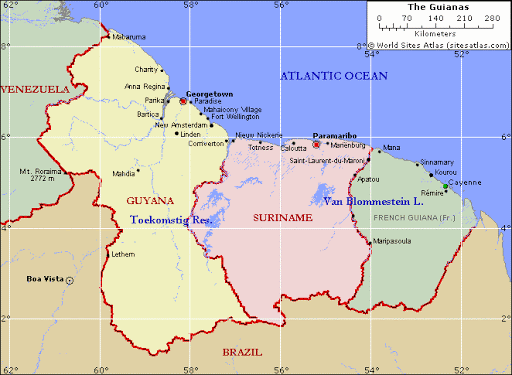This case concerned the delimitation of Guyana’s maritime boundary with Suriname and the alleged breaches of international law by Suriname in disputed maritime territory. The dispute arose in relation to the activities of holders of oil concessions granted by Guyana in the maritime area claimed by both countries. An oil rig and drill ship were ordered to leave and escorted from the area by the Surinamese navy in June 2000 and a similar incident followed in September 2000.
Guyana initiated arbitral proceedings on February 24, 2004, pursuant to Articles 286 and 287 and Annex VII of United Nations Convention on the Law of the Sea (“UNCLOS”). The three issues submitted to arbitration concerned: (i) the delimitation of the maritime boundary between the Parties; (ii) Guyana’s claim for damages resulting from Suriname’s activities with respect to the oil concession holders in the disputed area; and (iii) either Party’s alleged breach of its obligations under Article 74(3) and 83(3) of UNCLOS to make every effort “to enter into provisional arrangements of a practical nature” pending delimitation and “not to jeopardize or hamper the reaching of the final agreement.”
In respect of the delimitation of the maritime boundary in the territorial sea, the Tribunal applied the approach prescribed by Article 15 of UNCLOS, which places primacy on the median line as the delimitation line between the territorial sea of adjacent states, subject to “special circumstances”. The Tribunal found that special circumstances of navigation justified deviation from the median line. It found that the Parties’ colonial predecessors had agreed upon an N10°E line in the territorial sea, starting from the mouth of the Corentyne River in order to provide the Netherlands with appropriate navigational access, the Corentyne River being on the Surinamese side of the land boundary. Upon gaining independence, the Parties had each extended their territorial sea from 3nm to 12nm, without addressing the boundary of the territorial sea in the newly established limits. The Tribunal found that the need to prevent Guyana’s territorial sea from cutting across the approach to the Corentyne River at 3nm was a further special circumstance, which justified departure from the median line.
As regards the delimitation of the continental shelf and the exclusive economic zone pursuant to Articles 74 and 83 of UNCLOS, the Tribunal found clear guidance in the jurisprudence of the International Court of Justice (“ICJ”) and arbitral tribunals that this process should begin by positing a provisional equidistance line, which may be adjusted in light of relevant circumstances in order to achieve an equitable solution. Contrary to the submissions of both Parties, the Tribunal found that there were no relevant circumstances requiring adjustment to the provisional equidistant line.
Concerning the incidents in the disputed area, the Tribunal ruled that the Surinamese naval actions constituted a threat of use of force, contrary to international law, but denied Guyana’s request for monetary compensation.
The Tribunal found both Parties to be in breach of their obligations under Articles 74(3) and 83(3) of UNCLOS, to make provisional arrangements of a practical nature pending delimitation.

